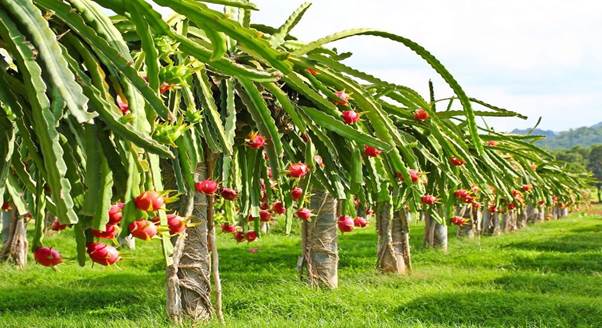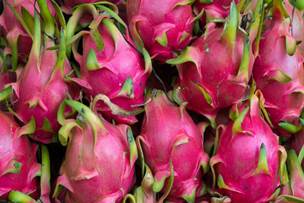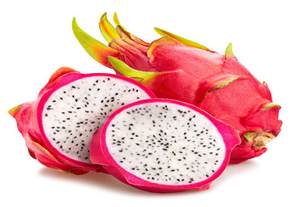Ministry of Agriculture &
Farmers Welfare
Kamalam (Dragon Fruit) cultivation area in India expected to expand to 50,000 hectares in five years under MIDH scheme from the present 3,000 ha.
Centre of Excellence (CoE) for Kamalam Fruit to be set up at IIHR, Bengaluru to help make Atmanirbhar Bharat by cutting down on its imports valued at about Rupees 100 crores in 2021
Posted On:
13 MAR 2023 8:03PM by PIB Delhi
Kamalam or Dragon Fruit, a herbaceous perennial climbing cactus widely known as Pitaya, has its origin in Southern Mexico, Central America and South America. It is widely cultivated in South-East Asia, India, USA, The Caribbean Islands, Australia throughout the tropical and sub-tropical world. Pitaya, called as Dragon fruit in English, is popular by different names such as Pithaya in Mexico, Pitaya Roja in Central and Northern America, Pithajah in Thailand and Kamalam after the Sanskrit name lotus in India. It is also known as “Wondrous Fruit of the 21st century”.
The Kamalam (Dragon fruit) has recently drawn much attention of the growers worldwide, not only because of their red purple colour and economic value as food products but also for their enormous health benefits. The skin of the fruit is covered with bracts or scales which may have attributed the fruits resembling the mythical creature "dragon', hence the name dragon fruit. Pitaya or dragon fruit is a climbing, fast growing perennial vine cactus species which originated from the tropical regions of Mexico and Central and South America. From its centers of origin, dragon fruit has spread over tropical and sub-tropical America, Asia, Australia and Middle East. Currently it is being cultivated in at least 22 countries of tropics. Historical evidence indicates that the French introduced the crop to Vietnam about 100 years ago and it was grown for the King. Later, it became popular among the wealthy families of the entire country.

In India, the cultivation of Kamalam Fruit is fast picking up and farmers of Karnataka, Kerala, Tamil Nadu, Maharashtra, Gujarat, Chhattisgarh, Odisha, West Bengal, Andhra Pradesh, Andaman & Nicobar Islands, Mizoram and Nagaland have taken up its cultivation. Presently, the total area under cultivation of Dragon Fruit in India is more than 3,000 ha. which is not able to meet the domestic demand, hence majority of the dragon fruits available in Indian market is imported from Thailand, Malaysia, Vietnam and Sri Lanka.
In India, Kamalam import started during 2017 with a quantity of 327 tonnes, which has increased sharply to 9,162 tonnes in 2019 and the estimated import for 2020 and 2021 is about 11,916 and 15,491 tonnes, respectively. The projected import value was about Rupees 100 crores for 2021. Dragon fruit provides fast return with economic production in the first year after planting and full production is attained in 3-4 years. The life expectancy of the crop is about 20 years. Average economic yield after 2 years of planting is 10 tonnes per acre. At present the market rate is Rs 100 per kg fruit, so the revenue generated by selling fruits per year is Rs 10,00,000. Benefit Cost Ratio (BCR) is: 2.58.


With focus on Atmanirbhar Bharat, there is need to reduce import and increase our own capacity for production. In this endeavor under Mission for Integrated Development of Horticulture (MIDH), a roadmap is being prepared for cultivation of this crop in the identified potential area to increase the production of exotic and niche area fruits including Kamalam. The target for area expansion under MIDH for Kamalam is 50,000 ha. in 5 years. The cultivation of this fruit has started recently and a plantation of this healthy fruit is established at ICAR-Central Island Agricultural Research Institute, Port-Blair, Andaman and Nicobar Islands and IIHR, Bengaluru, Karnataka.
Under MIDH, the Ministry of Agriculture & Farmers Welfare has approved a Centre of Excellence (CoE) for Kamalam Fruit to be established by Indian Institute of Horticultural Research (IIHR), Bengaluru, Karnataka at Hirehalli, Bengaluru, Karnataka on 09-03-2023 to focus on production, post-harvest and value addition of Kamalam.
The Centre will work for development of latest production technology as per the international standard & off season production and demonstration of these technologies for high yield production. The Centre will aim to achieve self-sustenance in Kamalam fruit production, value addition and enhancing economic development of the farming community.
The Centre of Excellence will focus on developing high performance variety with improved yield, nutrient use efficiency, nutritional quality, tolerance against biotic & abiotic stresses, Standardization of propagation techniques, distribution of quality planting material through public participatory approach, development of protocol for post-harvest handling and storage to reduce post-harvest losses and promote export to distant markets, development of value-added products and processes for product diversification & higher revenue realization, dissemination of developed technologies to the farmers & other stakeholders through training, field visits, etc.
With the growing interest in farmers and the quick returns that they are getting from cultivation of Kamalam in agricultural and marginal lands, it is expected that the new areas will come up under Kamalam and the import will be totally substituted through domestic cultivation.
****
SNC/PK
(Release ID: 1906572)